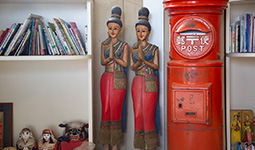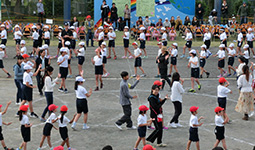Home > Highlighting JAPAN > Highlighting Japan June 2019 > Toward a Multicultural Symbiotic Society
Highlighting JAPAN


“Good Morning” in Ten Languages
Yokohama Municipal Iida Kita Icho Elementary School works to provide educational activities based on multicultural collaboration with local neighborhood associations and volunteer groups. Through these activities, children naturally develop open minds.
At the entrance to Iida Kita Icho is a sign that says “Good Morning” in ten languages, including Japanese. Of the school’s 235 students, half are of foreign nationalities or have foreign roots. The largest group of those students is Vietnamese, followed by respectively smaller groups of Chinese, Cambodian and Laotian students.
Principal Chizumi Miyazawa says, “Children belonging to the student government welcome other children who come to the school in many languages as part of their activities at the school entrance in the morning. We, the teachers, welcome those children with cheerful greetings so that we can be good role models.”
One of the elements behind the increase in the number of children of foreign nationalities was the arrival of refugees in the mid-1970s. With regime change in Vietnam, Laos and Cambodia, about 1.4 million people left their home countries and became refugees. In 1979, the Japanese government accepted some of these refugees and established settlement support centers that helped them to learn the Japanese language, culture and customs, and to settle in Japan. One of these centers existed in Yamato City, next to Yokohama, from 1980 to 1998.
At that time, many of the refugees who received Japanese language education and help in assimilating at this center started living in a housing complex managed by the prefecture inside the Iida Kita Icho school district, and an increasing number of children with links to the three Southeast Asian countries started attending the school. In the 1990s, more immigrants followed their family and friends to the area, which led to an increase in the number of children.
Responding to the situation, the school developed a multi-teacher educational system. Principal Miyazawa says, “We give lectures on Japanese and math in three to five classes according to the children’s Japanese abilities. For other subjects as well, there are assistant language teachers and Chinese, Vietnamese and Cambodian volunteer interpreters, as well as full-time teachers to support children in class. If children have anything that they cannot understand in class, the assistant language teachers act as interpreters so that children can answer in Japanese.”
Iida Kita Icho also puts importance on supporting the children’s parents.
Principal Miyazawa says, “We translate school documents for parents into Vietnamese, Chinese and Cambodian as much as possible. In addition, when we inform them of what to bring for a field trip, for example, we make it a rule to use pictures as much as possible, in addition to words. Interpreters also offer telephone consultations to parents.”
In school events, including sports day, children make announcements in their respective languages after the Japanese announcements so that parents who cannot understand Japanese can understand them. Parents and teachers also participate in a school-wide dance that is conducted on sports day, as a part of the day’s festivities. The school rotates between Chinese, Vietnamese and Cambodian dances annually. The support for these programs comes not only from the school, but also from the housing community association and volunteer groups supporting foreigners living in the community as part of their community activities.
Principal Miyazawa says, “Three years have passed since I became the principal of this school. During that period, I saw no children discriminate against foreign students or express prejudices toward them because of their nationality or differences in appearance, probably because our children have had close contact with people from diverse backgrounds since they were small children, and they have acquired the idea that “It is natural that all people are different.” I sincerely hope that they will convey this tolerance and acceptance of differences to others after graduation.”
The experience of accepting many foreigners and of living and learning together in the culture that was developed at the school not only promotes the ease and comfort with which children of foreign descent live but also greatly contributes to the mental growth of Japanese children.
© 2009 Cabinet Office, Government of Japan









